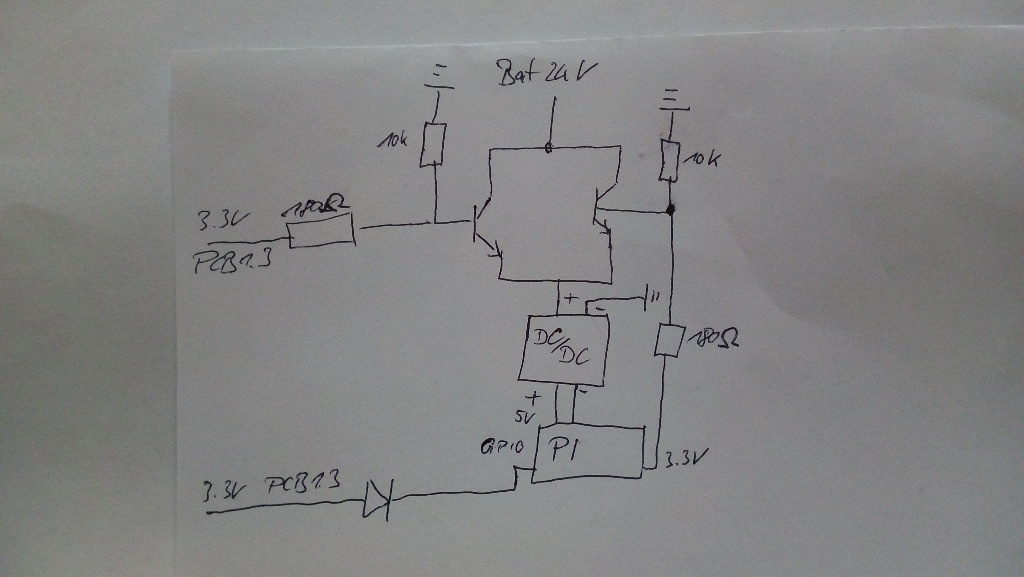Mein Hauptschalter ist von außen erreichbar. Mir ist schon mehrfach passiert, dass der Mower sich selbst ausgeschaltet hat, als er unter einem Strauch oder der Rutsche durch ist. Manchmal drückt auch eines der Kinder da drauf.
Beides würde den PI aus dem Leben reißen und mögilcherweise die SD Karte zerstören. Ich habe mir die bisherigen Anregungen angesehen, nun aber doch eine eigene Platine erstellt. Schaltplan siehe Anhang.
Das ganze läuft so ab. Sobald der Mower eingeschaltet wird, schaltet ein 3.3V Pin (vom DC/DC Pin Header) den ersten MOSFET (Irliz44n) durch. Somit wird der DC/DC Konverter mit Strom versorgt und liefert 5V für den PI. Dieser bootet nun. Ich habe einen OrangePI, dieser hat einen 3,3V Pin vom Spannungsregler am Pin Header. Solange der PI aktiv ist, liefert der Pin 3,3V. Ist der PI heruntergefahren, liegen keine 3,3V mehr vor, auch wenn der PI noch mit der Spannungsquelle verbunden ist.
Diese 3,3V nutze ich nun zum schalten eines zweiten MOSFET.
Zusätzlich gibt es eine Verbindung von den 3,3V des Mower zu einem GPIO Pin des PI (Sense).
Wird nu das PCB abgeschaltet (wegen Unterspannung, Schalter etc.), merkt dies der PI über die GPIOs und leitet einen Shutdown ein. Zeitgleich öffnet der erste MOSFET. Sobald der PI heruntergefahren ist, öffnet sich der zweite MOSFET durch das Wegfallen der 3,3V vom PI und die Schaltung ist stromlos.
Was meinen die Experten dazu? Reicht die Schaltung so aus? Irgendwelche Bedenken bezüglich der Bauteile, Ströme etc? Ich kenne mich da wirklich nicht aus.
The main issue I have is that my main switch is reachable outside the chassis.
It occured several times that the main switch gets switched to off either by an obstacle (tree) or by my children. Both cases may kill my SD card.
So I continued thinking about a solution and may found one. Please find schematics attached.
The PCB is direclty connected to battery, so powering off by main switch does not influence it.
As soon as PB 1.3 gets powered on, 3,3V coming from PCB switch a MOSFET (Irliz44n) to on. This powers the DC/DC converter which provides 5V for PI.
PI does now boots up. I use an OrangePI Zero which provides 3.3V over pin header if it is running (after shutdown 3,3v is lost). I use this 3.3V to enable a second MOSFET so PI is able to keep DC/DC alive.
If PCB1.3 is switched off (Undervoltage, Idle, Switch), PI recognise this by monitoring 3,3V from PCB1.3 via GPIO. Also MOSFET1 is open now. If GPIO is low, PI will shutdown. After shutdown is complete, 3,3V coming vom PI gets lost and opens MOSFET 2.
What do you think? Any issue with current flow or used parts? PLease let me know, I'm absolutely noob in electronics
Attachment:
https://forum.ardumower.de/data/med...dumower-PI-switch_Sheet-1_20180509085223.png/
